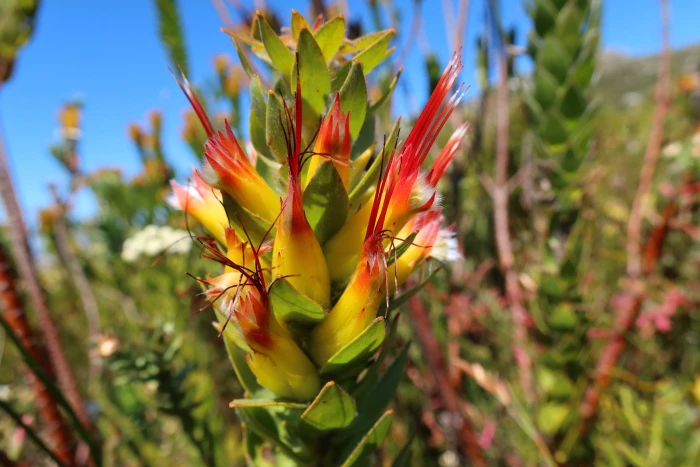Marsh Pagoda
(Mimetes hirtus)
Marsh Pagoda (Mimetes hirtus)
/
/

Diana Studer
CC BY 4.0
Image By:
Diana Studer
Recorded By:
Copyright:
CC BY 4.0
Copyright Notice:
Photo by: Diana Studer | License Type: CC BY 4.0 | License URL: http://creativecommons.org/licenses/by/4.0/ | Rights Holder: Diana Studer | Publisher: iNaturalist | Date Created: 2021-10-06T12:21:43-07:00 |





























Estimated Native Range
Climate Requirements for Culver City, California
| This Plant | Your Site | Plant Suitability for Your Location | ||
|---|---|---|---|---|
| • Precipitation | 14" - 32" | 13" | Your precipitation may be insufficient for this plant. Irrigate N" / year. | Irrigate N" / year |
| • High Temp. | 72°F - 91°F | 81°F | Your summer temperatures are normal for this plant. | Excellent |
| • Low Temp. | 33°F - 50°F | 48°F | Your winter temperatures are normal for this plant | Excellent |
This plant should grow well at your location with about N inches per year (Y minutes per month) of irrigation.
Summary
Mimetes hirtus, commonly known as Marsh Pagoda, is an evergreen shrub native to the fynbos region within the Cape Provinces of South Africa, where it thrives in mountainous areas and on rocky slopes. It typically grows to a height of 5-7 feet and a width of 1-3 feet. The plant has a distinctive appearance with its upright stems and bright inflorescences composed of tubular flowers that are pink, red, and green, blooming in winter and spring. The flowers are particularly showy, attracting pollinators such as birds and insects.
Marsh Pagoda is appreciated for its unique floral display and is often used in ornamental gardens for its striking color and form. It is also valued for its adaptability to different soil types, provided they have good drainage. In cultivation, it requires full sun exposure and can tolerate medium to high water conditions, though it is adapted to the Mediterranean climate of its native range, which includes wet winters and dry summers. While generally easy to maintain, it is susceptible to root rot if overwatered or planted in poorly draining soils. Gardeners should be aware that Mimetes hirtus has a relatively short lifespan, with vigorous early growth and abundant flowering that typically declines after about fifteen years.CC BY-SA 4.0
Marsh Pagoda is appreciated for its unique floral display and is often used in ornamental gardens for its striking color and form. It is also valued for its adaptability to different soil types, provided they have good drainage. In cultivation, it requires full sun exposure and can tolerate medium to high water conditions, though it is adapted to the Mediterranean climate of its native range, which includes wet winters and dry summers. While generally easy to maintain, it is susceptible to root rot if overwatered or planted in poorly draining soils. Gardeners should be aware that Mimetes hirtus has a relatively short lifespan, with vigorous early growth and abundant flowering that typically declines after about fifteen years.CC BY-SA 4.0
Plant Description
- Plant Type: Shrub
- Height: 5-6.5 feet
- Width: 1-3 feet
- Growth Rate: Moderate
- Flower Color: Pink, Red, Green
- Flowering Season: Winter, Spring
- Leaf Retention: Evergreen
Growth Requirements
- Sun: Full Sun
- Water: Medium, High
- Drainage: Medium, Fast
Common Uses
Bird Garden, Border Plant, Butterfly Garden, Potted Plant, Showy Flowers
Natural Habitat
Fynbos region within the Cape Provinces of South Africa, particularly mountainous areas and rocky slopes
Other Names
Common Names: Red And Yellow Bottlebrush, Tall Pagoda, Hairy Mimetes, Pineapple Bush, Kreupelboom, Vleistompie, Rooistompie, Pynappelstompie
Scientific Names: Mimetes hirtus, Mimetes capitulata, Leucadendron hirtum, Scolymocephalus hirtus
GBIF Accepted Name: Mimetes hirtus (L.) Salisb. ex Knight